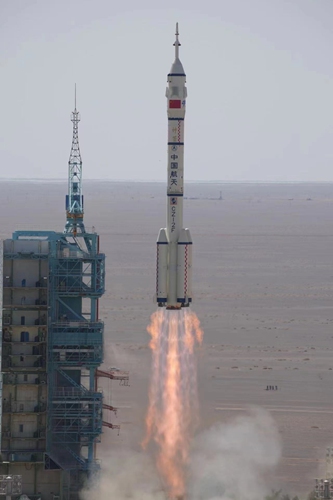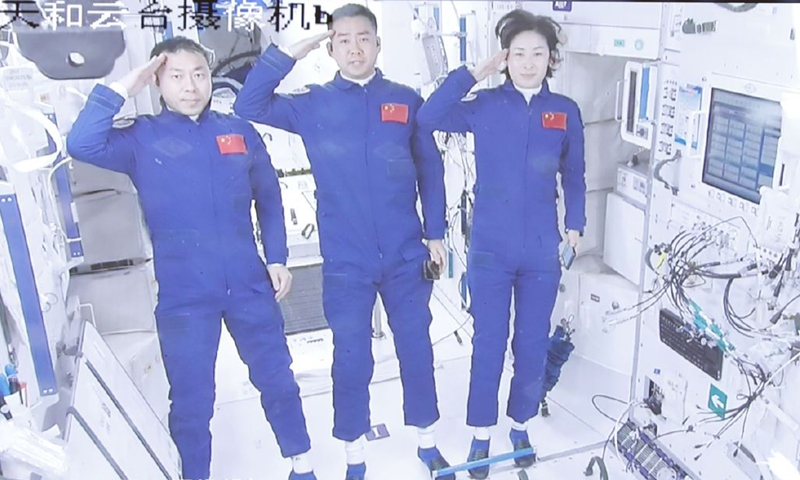China's Tianhe space station core module and Tianzhou-3, -4 cargo spacecraft combination have received a new crew of taikonauts, some 10 hours after the mission was launched from Jiuquan Satellite Launch Center in Northwest China's Gansu Province on Sunday.
The Shenzhou-14 manned spacecraft docked with the radial port of Tianhe space station core module at 5:17 pm Sunday, and the trio of taikonauts entered the Tianhe space station core module at around 8:50 pm, the China Manned Space Agency (CMSA) said in a statement sent to the Global Times.
The new combination flight consists of the Tianhe core module at the center, the Shenzhou-14 manned craft at the bottom, and Tianzhou-3 and -4 cargo craft on the side.

The Shenzhou-14 spacecraft on the Long March 2F rocket lifts off on June 5, 2022 at Jiuquan Satellite Launch Center in Northwest China's Gansu Province. Photo: cnsphoto
Sitting atop the Long March-2F Y14 carrier rocket and carrying three taikonauts - the third crew group to enter China's Tianhe space station core module - the Shenzhou-14 was launched at 10:44 am on Sunday, amid sweaty palms and pounding hearts of millions of thrilled stargazers across the world.After a flight of around 577 seconds, the Shenzhou-14 manned spacecraft separated from the rocket to enter its designated orbit, with the crew onboard in good condition, marking a full success of the launch mission, the Global Times learned from the CMSA.

Shenzhou-14 taikonauts Cai Xuzhe, Chen Dong and Liu Yang (from left) made a salute to the motherland and Chinese compatriots on earth after the third crew of China's Space Station entered the Tianhe core module on June 5.
The Shenzhou-14 marks the first crewed spaceflight mission to the Tianhe at the China Space Station in-orbit assembly stage.
The Wentian and Mengtian space station lab modules, the Tianzhou-5 cargo spacecraft, and the Shenzhou-15 manned spacecraft are expected to be launched during the Shenzhou-14 crew's six-month stay in orbit. This will be a record for the crewed Tianhe, as during the two previous crewed missions, there were not so many launches.
The space station combination would also see the simultaneous stay of six taikonauts in orbit, and as the Shenzhou-14 and Shenzhou-15 crew members are expected to conduct their rotation in orbit for about a week, which would be another breakthrough in China's manned spaceflight history.
Younger line-upSenior Colonel Chen Dong, 44, is a veteran taikonaut who visited space in China's Shenzhou-11 manned space mission in 2016 and set the previous record for the longest stay in space by a Chinese spacefarer at 33 days for his stay on the Tiangong-2 space lab.
The record was broken by Shenzhou-13 taikonaut Wang Yaping in 2022, and Chen would be able to surpass that with another 180 days in space in the Shenzhou-14 run.
Senior Colonel Liu Yang, a 44-year-old female crew member joining Shenzhou-14 previously went to space in 2012 on the Shenzhou-9 mission and was the first Chinese woman to do so. At a press conference on Sunday, she said that for the upcoming six-month mission, she and her crewmates are looking forward to celebrating for the first time the birthday of their motherland on October 1 as well as the Mid-Autumn Festival, a holiday for the reunion and gathering of the Chinese people. This year's Mid-Autumn Festival falls on September 10.
Senior Colonel Cai Xuzhe, 46, is making his maiden space voyage during the upcoming mission. "For this day, I have prepared 12 years. I feel honored and proud to have this chance to go into space for my country," he said.
The Shenzhou-14 crew are members of the second cohort of taikonauts China has trained.
Commenting on the younger lineup in which the older, first group of veterans are not included, Pang Zhihao, a Beijing-based senior space expert said that the new Shenzhou taikonaut trio must have showed outstanding performance during training, and the younger crew members have mastered new knowledge and skills for the mission.
Pang told the Global Times that the Shenzhou-14 crew is still made up of two veterans and one newcomer just like the Shenzhou-12 and Shenzhou-13 missions. The younger crew members would have better stamina and could deliver on more complicated tasks such as the installation and testing of the two lab modules.
Mission commander Chen said at the press conference on Saturday, "Our crew are relatively young, but we have full preparation, fiery passion, and strong confidence. With 12 years of living together and 2.5 years of mission training, we have grown more and more familiar with each other, and our minds, actions, and aims are united. Although I have shouldered the pressure, there is also more confidence and determination to complete this task."
Most complicated mission everThe trio is slated to carry out the verification of big and small robotic arms, spacewalks, and the construction of payload outside the cabin, the Global Times learned from the Shenzhou spacecraft developer with the state-owned aerospace contractor China Aerospace Science and Technology Corp (CASC.)
The Shenzou-14 crew's stay in orbit will see nine modifications of the space station combination, with five rendezvous and dockings, three separations and two module relocations, which makes it the most complicated in-orbit mission to date, Guo Zhi, a senior engineer with the Xi'an Satellite Control Center, told the Global Times on Sunday.
The center vowed to continue to update its computing system, optimize its orbit calculation mode, and combining ground station, space-borne monitoring technology as well as data from China's home developed BeiDou Navigation Satellite System (BDS) to ensure the successful execution of the mission.
Like during the previous missions, the Shenzhou-14 crew will give Tiangong classes to earthbound youngsters, and will for the first time use the airlock cabin in the Wentian module to exit the station for extravehicular activities. These activities will be scheduled two to three times during their stay, the Global Times has learned.
The basic structure of the space station will be completed during this mission, consisting of the Tianhe core cabin and the two lab modules - the Wentian expected in July and Mengtian in October. The Wentian module along with the Long March-5B Y3 carrier rocket has already been transported to the Wenchang Spacecraft Launch Site on May 29 for assembly and testing, announced the CMSA.
Upon completion, China will establish a national space laboratory.
The laboratory will contain 25 cabinets for a variety of scientific experiments, each of which can function as an individual lab, reaching an overall international advanced level, Lin Xiqiang, deputy head of the CMSA Engineering Office, told the Global Times.
The Wentian lab will mainly focus on the study of space life sciences, which can support the growth, development, genetics and aging of multiple species of plants, animals and microorganisms under space conditions.
The Mengtian lab will be oriented to microgravity scientific researches and is equipped with experimental cabinets for fluid physics, materials science, combustion science, basic physics and space technology experiments.
Later, a space telescope research facility, the Xuntian telescope, will launch into orbit and fly with the space station to carry out wide-area survey observations.
Another highlight for the Shenzhou-14 mission is the maneuvering of a small robotic arm installed on the Wentian module. Compared with the large robotic arm which was launched into space with the Tianhe core cabin, the small one is more compact, Lin noted.
The weight and length of the small robotic arm are about half of the large one, and the load capacity is about one-eighth of the large arm. It also has a more flexible movement and manipulation than the large arm.
The small robotic arm has a higher positioning accuracy, with its positioning precision five times better than the large arm, and altitude control twice as precise. Therefore it can complete more fine operations.
What's more, the small and large robotic arms can coordinate with each other to cover wider scopes of work outside the cabin, and the combination is capable of achieving a greater variety of tasks.
The most complex in-orbit mission has brought with it greater challenges, not only from the heavier tasks but the impact of epidemic. Lin told the Global Times that the challenge was particularly grave as many regions in China, including Beijing, Shanghai, Xi'an, and Changchun, were overshadowed by Omicron.
However, they have beaten all the odds to ensure each step in the aerospace system is steady and safe. To guarantee staff members in the system, especially the taikonauts, do not get infected, they have followed the strictest anti-epidemic rules to the highest standard. Since March, all taikonauts were under strict closed-cycle management to safeguard their training program.
The Shenzhou-13 mission safely returned back to Earth on April 16 in a historic feat, thus concluding the technology verification stage of China's space station. The three crew members - Zhai Zhigang, Wang Yaping, and Ye Guangfu - completed their quarantine smoothly with cardiopulmonary functions and other body indicators recovering to their pre-flight levels.
They are currently in the second phase of recovery that focuses on muscle and bone recovery. In general, the three taikonauts are in good physical and mental condition, and the recovery of various physiological and psychological indicators is in line with expectations, the Global Times has learned.





